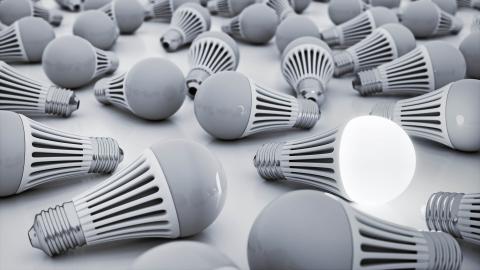
Q:What’s the best way to collect and use baseline data for a direct-install LED program?
A:Gathering baseline data to determine the savings estimates from an installed measure, such as an LED fixture, requires careful coordination among the program implementer, the utility, and the evaluator. Ideally, the program implementer would gather site-specific information—including location, hours of use, and other pertinent data—when installing new LEDs at a customer’s location. The National Renewable Energy Laboratory’s (NREL’s) Commercial and Industrial Lighting Evaluation Protocol (PDF) and Residential Lighting Evaluation Protocol (PDF) provide clear guidance on the data you should collect to estimate the lighting savings for lighting products implemented through a variety of program designs. Both protocols emphasize that for direct-install programs, the implementation contractor should collect baseline wattage information when the measure is installed.
Ideally, the program implementer would gather site-specific information—including location, hours of use, and other pertinent data—when installing new LEDs at a customer’s location.
Unfortunately, program implementation and evaluation activities aren’t always coordinated, and thus the critical data needed to calculate the savings aren’t always available. Many states now rely on the average wattage calculations that are deemed and reported in technical reference manuals (TRMs).
The deemed-savings calculations were developed based on previous metering studies or evaluations and have been carefully vetted and reviewed prior to inclusion. In fact, deemed-savings estimates have become standard practice as an alternative to more-expensive evaluation activities, such as on-site metering. Energy organizations also routinely update these estimates to ensure that the savings reflect changing market conditions. You can find an example of this recalibration in Focus on Energy Evaluated Deemed Savings Changes (PDF).
Deviating from the standard or approved deemed savings in a TRM, especially for lighting products, requires developing a substantial burden of proof to override the savings numbers reported in the TRM. Some states, such as Arkansas, California, and Massachusetts, don’t permit evaluators to replace deemed-savings numbers in the TRM without first gaining approval from the public utilities commission or the state’s independent evaluation monitor or evaluation, measurement, and verification adviser.
Sending data
Most utilities send evaluation data, including any customer records or program databases, through password-protected FTP sites that are designed to protect data integrity and customer privacy. There are a variety of software platforms available, including SharePoint from Microsoft or similar products from Cisco, SAS, Dropbox, and other firms as described in the WPBeginner article 6 Best FTP Clients for Mac and Windows WordPress Users.
Evaluating program results
Evaluators use baseline estimates to calculate the change in energy consumption that occurred prior to the installation (baseline) of the new measure. NREL’s Commercial and Industrial Lighting Evaluation Protocol summarizes the evaluation approach:
Project and program savings for lighting and other technologies result from the difference between the energy consumption that would have occurred had the measure not been implemented (the baseline) and the consumption occurring after the retrofit.
Energy calculations use the following fundamental equation:
Energy Savings = (Baseline-Period Energy Use – Reporting-Period Energy Use) ± Adjustments
The equation’s adjustment term calibrates baseline or reporting use and demand to the same set of conditions. Common adjustments account for changes in schedules, occupancy rates, weather, or other parameters that can change between baseline and reporting periods.